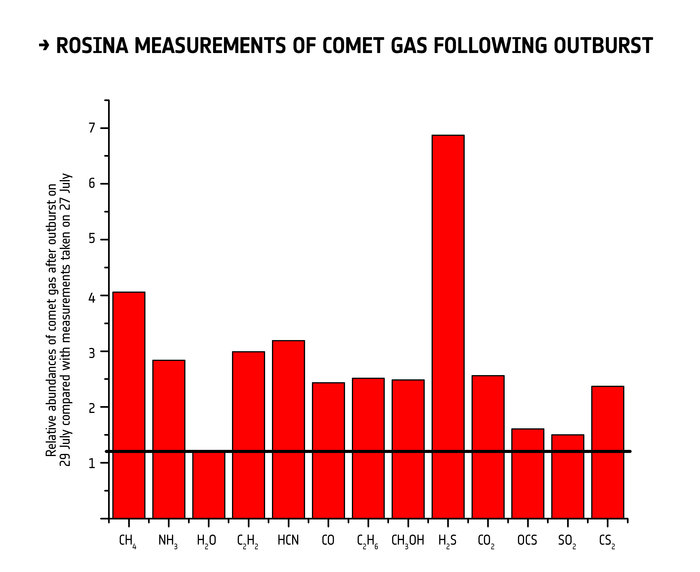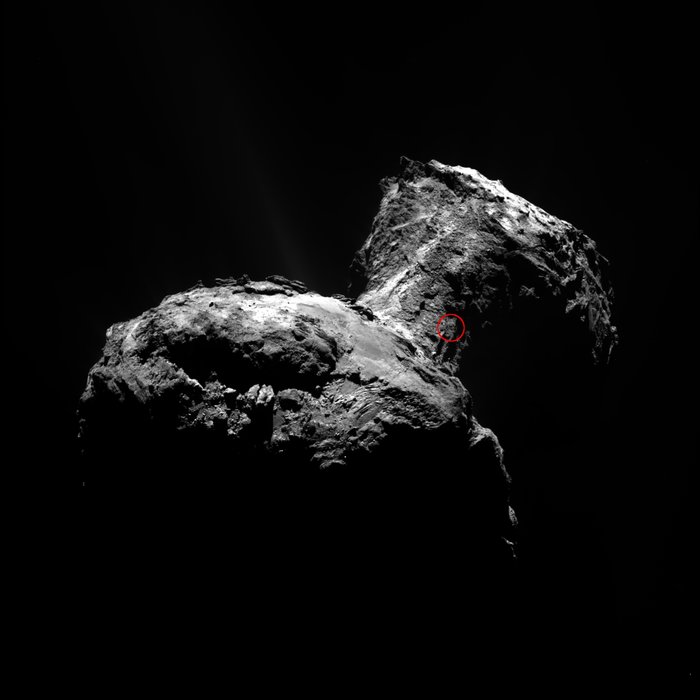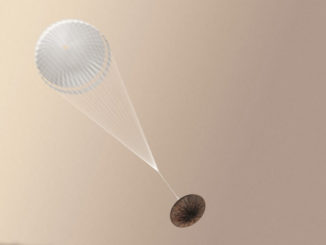
Europe’s Rosetta spacecraft has recorded a brilliant beam of gas and dust shooting into space from Comet 67P/Churyumov-Gerasimenko, the most spectacular such emission since the probe arrived at the tiny frozen world one year ago.
The jet appeared suddenly 29 July, emanating from the neck region connecting two large lobes of the duck-shaped comet. The eruption came two weeks before Rosetta and its cometary target reach perihelion 13 August, the closest point in the comet’s 6.5-year circuit around the sun.
The outburst gave scientists a rich insight into the workings of the comet, but it also introduced caution into Rosetta’s flight plan. Engineers are worried dust could interfere with Rosetta’s navigation system — as it has before — and the probe is now positioned more than 300 kilometres (186 miles) from the comet.
“This is the brightest jet we’ve seen so far,” said Carsten Güttler, OSIRIS team member at the Max Planck Institute for Solar System Research in Göttingen, Germany. “Usually, the jets are quite faint compared to the nucleus and we need to stretch the contrast of the images to make them visible — but this one is brighter than the nucleus.”

Rosetta’s sharp-eyed OSIRIS camera caught the plume in its viewfinder, and another sensor on Rosetta detected spikes in the abundances of several molecules in the coma, or gas cloud, surrounding Comet 67P. Compared to measurements two days earlier, carbon dioxide levels doubled, methane concentrations quadrupled and hydrogen sulfide increased by a factor of seven, according to ESA.
“This first ‘quick look’ at our measurements after the outburst is fascinating,” said Kathrin Altwegg, principal investigator for Rosetta’s ROSINA instrument at the University of Bern. “We also see hints of heavy organic material after the outburst that might be related to the ejected dust. But while it is tempting to think that we are detecting material that may have been freed from beneath the comet’s surface, it is too early to say for certain that this is the case.”
A human sniffing the mixture of gases around Comet 67P would likely recoil in disgust. Hydrogen sulfide, for example, gives off the foul odor of a rotten egg.
The jet was at its most intense for just a few minutes. In the course of less than 40 minutes, the plume suddenly shot out from the comet’s collar and rapidly weakened.

The material in the jet traveled at least 10 metres per second (22 mph), according to estimates from Rosetta’s camera team.
Readings from Rosetta’s magnetometer showed the brief eruption pushed back against the solar wind, the supersonic stream of particles moving away from the sun, creating a bubble around the comet’s nucleus unlike anything observed by Rosetta up to that point.
“The solar wind magnetic field starts to pile up, like a traffic jam, and eventually stops moving towards the comet nucleus, creating a magnetic field-free region on the sun-facing side of the comet called a ‘diamagnetic cavity’,” said Charlotte Götz, magnetometer team member at the Institute for Geophysics and extraterrestrial Physics in Braunschweig, Germany.
Europe’s Giotto mission registered the only other detection of such a cavity around a comet before now, when it flew past Halley’s Comet in 1986.
Matt Taylor, Rosetta’s project scientist at the European Space Agency, told Astronomy Now the outburst was not the first observed by the mission since it arrived at comet 67P in August 2014.
“This one was pretty spectacular though, in particular the magnetic cavity,” said Taylor, whose research interests are in plasma physics. “Excellent stuff! Plasma physics phenomena that we can study in situ at the comet that are ubiquitous throughout the cosmos.”
The comet activity pushed the boundary with the incoming solar wind out at least 186 kilometres (115 miles) form the nucleus, where Rosetta was located during the outburst.
“Finding a magnetic field-free region anyway in the Solar System is really hard, but here we’ve had it served to us on a silver platter – this is a really exciting result for us,” Götz said.

A dust counter aboard Rosetta also recorded fingerprints of the 29 July outburst lingering days after the event, logging 70 impacts by tiny dust fragments in a four-hour period on 1 August. Scientists said the dust sensor registered only a handful of strikes per day earlier in July, and the grains reaching Rosetta after the outburst were hitting at much higher speeds, according to Alessandra Rotundi, principal investigator for Rosetta’s GIADA dust counter at the ‘Parthenope’ University of Naples, Italy.
Scientists dispatched Rosetta on a 10-year journey to a comet to witness how such an object, thought to be a primordial building block left over from the birth of the solar system, evolves over the course of an orbit around the sun.
Rosetta parked alongside Comet 67P in August 2014, dropped the Philae lander to its surface in November, and then kicked off a year-long campaign to track the comet’s changes as it arcs toward the sun.
The comet, and Rosetta, reach their closest approach to the sun Thursday at a range of 186 million kilometres (115 million kilometers), between the orbits of Earth and Mars.
Models predict the comet will most active a few weeks later, just as the hottest days of summer lag the longest day of the year.
As ground controllers expected, the turbulent cloud of dust and gas around the comet has forced Rosetta to back off.

Rosetta’s star trackers, which lock on to bright stars to inform the craft’s computers which way it is pointing, have mistaken nearby dust grains for guide stars several times, confusing the probe’s navigation system.
Now the gas and dust is slowly pushing Rosetta off course, Taylor told Astronomy Now.
“Activity is now ‘felt’ by the spacecraft, so that we have to course correct a little every so often due to perturbation on the spacecraft,” Taylor said.
The dynamic situation has put efforts to establish a stable radio link with the Philae lander, which roused from hibernation and contacted Rosetta in June, lower on mission managers’ priority list.
The last signal from Philae came 9 July, and Rosetta is now flying much farther from the comet — about 300 to 340 kilometres (186 to 211 miles).
“This reduces the signal strength of Philae, which we haven’t heard from for a few weeks now,” Taylor said. “An additional thing to consider is that we expect to only be able to hear from Philae in a limited region of the sky on the comet, which is constrained to parts of the northern hemisphere.
“Rosetta science needs to see as much of the comet as we can, in particular we want to look at the southern hemisphere, which only came into sunlight in May this year, and has a very short summer up to March next year,” Taylor said.
Email the author.
Follow Stephen Clark on Twitter: @StephenClark1.
Inside the magazine
Find out more about Rosetta’s first year at the comet in the August 2015 issue of Astronomy Now the UK’s biggest and longest running astronomy magazine.
Never miss an issue by subscribing. Also available for iPad/iPhone and Android devices.




